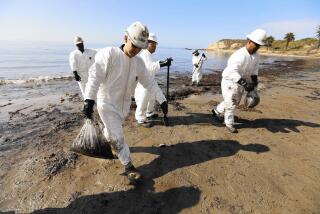New Keystone pipeline route proposed; activists block Texas site
Activists battling a new oil pipeline chained themselves to bulldozers in Texas on Wednesday, temporarily halting route-clearance work in the latest protest against the Keystone XL project to carry oil from the tar sands of northern Canada.
But TransCanada, the company that hopes to build the pipeline, took an important step forward with a proposed new route for the northern segment of the line. The company says the route would skirt the delicate Nebraska Sandhills, the permeable sands that lie atop one of the nation’s most important agricultural aquifers.
The new route is designed to counter significant opposition in Nebraska, where ranchers and environmental activists have been worried about possible leaks of diluted bitumen into the aquifer. Their protests prompted President Obama to veto the company’s initial application for an international permit to cross the U.S.-Canadian border.
TransCanada, meanwhile, has pressed forward. The company came out Wednesday with the proposed new routing for the northern segment of the pipeline, and it’s been pushing ahead with construction of the southern portion of the structure.
The southern portion, which doesn’t require an international permit, was the portion of the project targeted by activists Wednesday. They chained themselves to bulldozers that were preparing to clear large trees near Saltillo, Texas, for the pipeline’s path.
Hopkins County sheriff’s deputies arrived at the scene but left without taking action, and an estimated 30 construction workers turned back from the worksite, according to Ramsey Sprague, a spokesman for Tar Sands Blockade. The group is coordinating a series of rolling protest actions along the proposed southern route through Texas and Oklahoma.
“They conferred with each other for quite a long time about how to handle the situation, and ultimately resolved just to leave,” Sprague told the Los Angeles Times.
He said the protesters would remain for at least several hours. “We’re going to stay at the site to ascertain that it’s a full workday shutdown and declare victory. And move on to our next location,” Sprague said.
In Nebraska, meanwhile, the proposed new route skirts some of the areas about which residents and the state Department of Environmental Quality had expressed their greatest concern. Among them are a wellhead protection area in the town of Clarks and other areas not technically within the Sandhills but which have the same sandy, erodible soils with thin topsoil that are characteristic of the Sandhills.
“Based on feedback from the Nebraska Department of Environmental Quality and the public, we have refined our proposed routing of the Keystone XL pipeline,” TransCanada President Russ Girling said in a statement. “The preferred alternative route … was developed based on extensive feedback from Nebraskans and reflects our shared desire to minimize the disturbance of land and sensitive resources in the state.”
Those in Nebraska who have expressed the strongest opposition to Keystone XL, however, were not swayed. They said the new route also leaves many critical areas of the state vulnerable in the event of a leak.
“The new route still risks our land, water and property rights. The new route still crosses high water tables, sandy soil which leads to higher vulnerability of contamination and still crosses the Ogallala Aquifer, the lifeblood of Nebraska’s economy,” Jane Kleeb, head of the activist group Bold Nebraska, said in a statement.
ALSO:
PCP eyed as trigger in gruesome attacks on children
Wolves not endangered in Rockies? Activists arm for fight
Congressional forecast: Fight over coastal flood protection funds
Follow Kim on Twitter @kimmurphy. Email: kim.murphy@latimes.com
More to Read
Sign up for Essential California
The most important California stories and recommendations in your inbox every morning.
You may occasionally receive promotional content from the Los Angeles Times.










